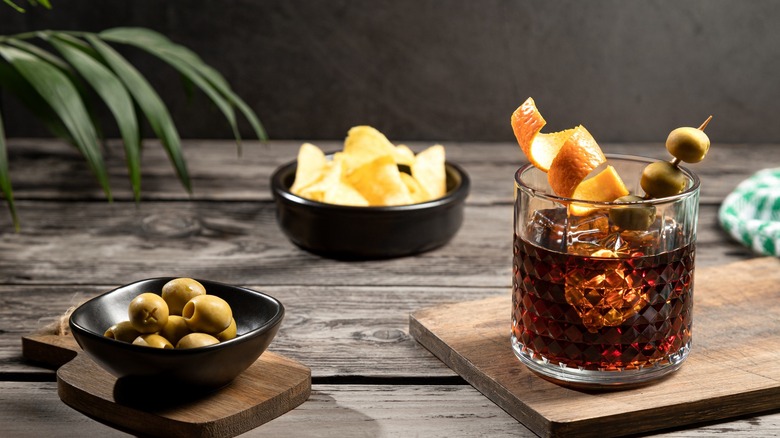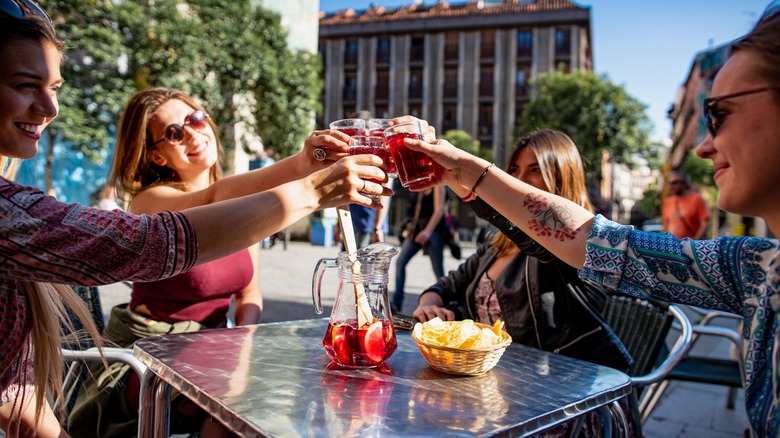For Less Bitter Vermouth Cocktails, Try The Spanish Variety
Vermouth comes in a veritable spectrum of flavors and aromas, from the floral and bitter kick of dry vermouth to the sugary yet spicy essence of sweet vermouth. It's perfect for charcuterie boards and cocktails. Every brand's recipe is distinct, but the Italian and French varieties are usually listed as the baselines. Spanish vermouth, however, presents a unique third option that's difficult to categorize into either type. The drink's caramelly rouge color is distinct from vermouth's usual white and red hues, and its particular blend of spices may attract those who find dry vermouth to be too sharp and sweet vermouth to be too cloying. This helps keep cocktails from being overwhelmingly bitter and lends a complicated but delightful note to traditional recipes.
Purportedly, vermouth found its way into Spain through Italians traveling from Turin, often cited as the birthplace of at least the modern iteration of the beverage (though its fortified wine ancestor has links to Rome in the 1500s). The Torinese used Spanish grapes to make the fortified wine, but it's the aromatics — citrus and spices from North Africa that are commonly incorporated into Spanish cuisine — that truly distinguish Spanish vermouth from its Italian and French counterparts.
Spanish vermouth is perfect for snacks and cocktails
Spanish vermouths are often citrusy in flavor due to fruity additions, slightly similar to that other iconic Spanish wine-based concoction known as the sangria. However, whereas sangria typically is sweeter, Spanish vermouths have a spiciness to balance out the flavor notes. This is due to the common addition of infusions like cinnamon and cloves, holdovers from the North African spice trade in the region. As a garnish, Spanish vermouth is often served with an orange or lemon peel or a manzanilla olive stuffed with anchovies.
Of course, just as is the case with red and white vermouths, there are countless subtle differences between the brands that make rich caramel Spanish vermouths. The European Union dictates that vermouths need to be at least 75% wine, must have an alcohol content between 14.5% and 22%, and must contain wormwood, the herb that gives vermouth its distinctly bitter undertone. Everything else is up to interpretation, lending the drink its characteristic diversity.
Yzaguirre Rojo Vermouth might just be the purest example of the classic Spanish style with its distinct notes of orange and cinnamon — though there are plenty of other choices to sample. When experimenting, start simple and enjoy a smooth Spanish vermouth and soda — or try an orange mandarin negroni or a Bronx cocktail where the citrus and spicy tones of Spanish vermouth will pair beautifully with the fresh orange juice.
Why Spain loves vermouth
Vermouth has been an essential part of Spanish culture for decades, acting as a social and culinary primer on weekend afternoons, especially after church on Sundays when it's complemented with pub fare, like hard cheeses, chips, and cured meats. The drink lost its stature immediately after the fall of dictator Francisco Franco when Spain was trying to shed its traditional ways of life in favor of a bright new democratic era. However, because being a democracy doesn't mean not being delicious, vermouth has made a gigantic comeback in the past decade.
The cradle of vermouth in Spain is the Catalonia region, specifically the town of Reus, where a grape-killing blight in the nineteenth century forced vineyards to get creative with their wine production. Just over seventy miles to the east, customers pack vermouth bars in Barcelona's hipster neighborhoods in the middle of the day. The beverage is so essential to culture in these parts that the Catalan saying "fer un vermut" (to do a vermouth") expresses the mere act of socializing over a glass (or two or three). Of course, the beverage has spread beyond the Mediterranean coast, as well. Madrid also has its fair share of vermouth bars, and Spain's Basque country along the northern coast is currently in the midst of its own unique vermouth revolution defined by local grapes and highly aromatic flavorings with an emphasis on cherry instead of citrus.



